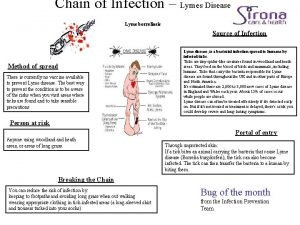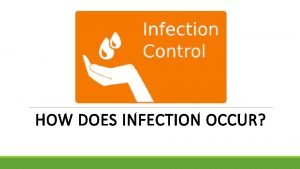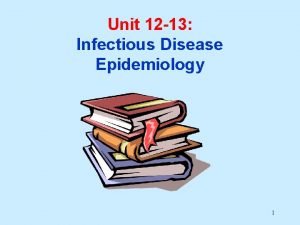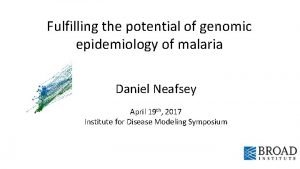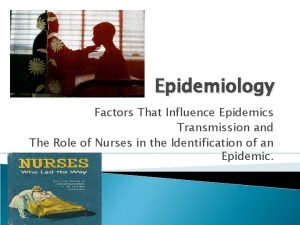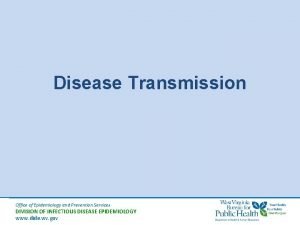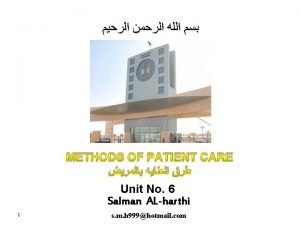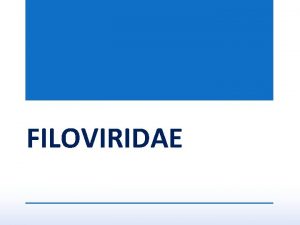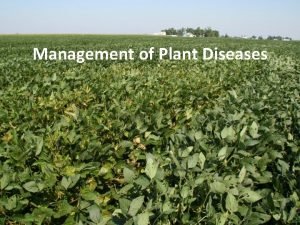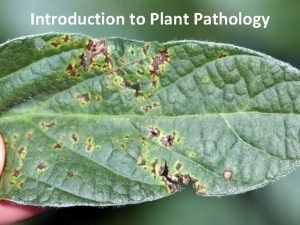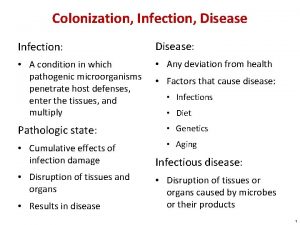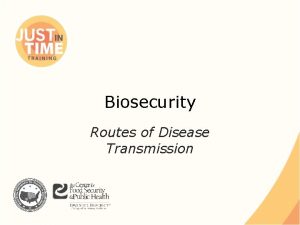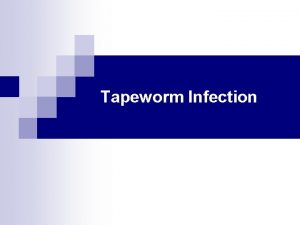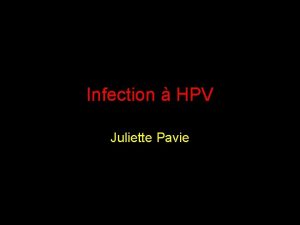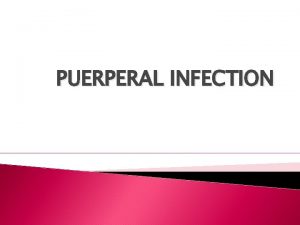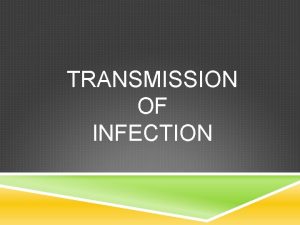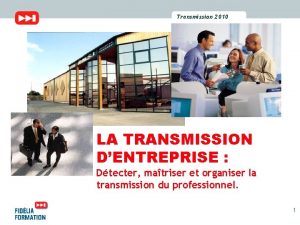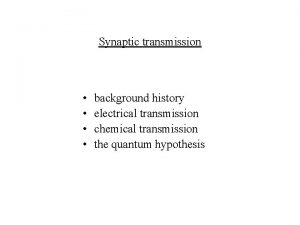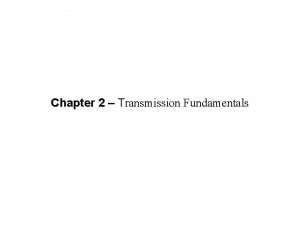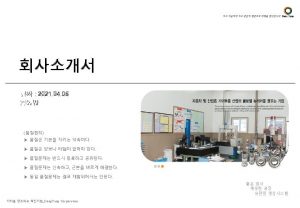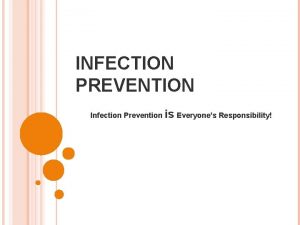Disease Transmission 2 A Cycle of Infection The



















![Homework [1] • Write short note about Lyme disease, including only the following? Short Homework [1] • Write short note about Lyme disease, including only the following? Short](https://slidetodoc.com/presentation_image_h/23f9ea24f2a9bb3093f1c8488c8ed132/image-20.jpg)



- Slides: 23


Disease Transmission 2

A. Cycle of Infection • The cycle of infection is sometimes referred to as the chain of infection, and describes how infections are contracted, and spread from one individual to another. • The cycle of infection begins with the infectious agent, and ends upon infecting the susceptible host. 3 pathogen Susceptible host Reservoir Entry portal Exit Portal Transmission

A. 1. The Pathogen • Breaking the cycle of infection and stopping the spread of infection at the infection agent (pathogen) point requires that contaminated objects are cleaned, disinfected, or sterilized. • So its a microorganisms spread preventing. • The infectious agent or pathogens in healthcare frequently contracted through three routes: 1. blood borne; 2. airborne; and 3. contact. 4

A. 2. Routes of Pathogen Transmission Route Blood borne Airborne Contact 5 Description Disease Contact with infected blood. Needle stick or broken skin Hepatitis AIDS Pathogens disperse via droplet or in air during speech. e. g. cough or sneeze Tuberculosis (TB) Multidrug-resistant tuberculosis (MDR TB) measles, chicken box Touching patient himself, blood, body fluid, contaminated surface. MRSA VER CDC

A. Cycle of Infection cont’d • The reservoir of infection refers to the environment in which a pathogen can grow and multiply. • The human body provides a very suitable environment for growth, providing nutrients, moisture and warmth. • Carriers are persons who carry pathogens with no symptoms of disease. • Carriers often unknowingly and accidentally transmit infections to susceptible individuals. 6

A. 3. The Reservoir • Breaking the cycle of infection and disease spread at the reservoir level requires the technologist control sources of body fluids and drainage. • This requires hand hygiene, proper disposal of contaminated tissues, dressings, linens, and needles. • Ensuring that exam tables and equipment be cleaned and dried after every patient. 7

A. Cycle of Infection cont’d • The susceptible host or recipient of infection often includes: Ø Elderly and pediatric populations. Ø Any patient with lowered immunity due to disease or medical treatment (e. g. cancer patient receiving chemotherapy, or a patient whose immunity is lowered due to burns or trauma). Ø Post transplant patients. Ø Malnutrition populations. Ø Drugs users. 8

A. 4. The Host • Health care professionals can become susceptible hosts when their resistance is lowered due to fatigue, stress or poor eating habits. • Technologists can assist in halting the cycle of infection by ensuring they have: Ø Adequate nutrition. Ø Adequate rest. Ø Maintain up to date vaccinations. Ø Stay home when ill. 9

A. Cycle of Infection cont’d • In a human reservoir, portals refer to openings or mechanisms through which a pathogen can gain access to or leave a host. • Portals include openings that provide a channel for movement of secretions and excretions, through the nose, mouth, urinary or intestinal tract. • An open wound or injection site through which body fluids can escape may also provide access for entry and or exit of pathogens. 10

B. Transmission of Diseases • Disease causing pathogens spread from individual to individual or object to individual in a predicable manner. • Knowledge of the infectious cycle enables the technologist to use methods to prevent a pathogen from progressing in its life cycle. • An understanding of the methods by which pathogens are transmitted enable one to stop the spread of pathogens among the healthy and unhealthy population. 13

B. Transmission of Diseases • Disease may be transmitted via 6 major routes: Direct Contact Droplet Contamination Vehicle Indirect Contact Airborne Contamination Vector 14

B. 1. Direct Contact • Occurs when a diseased person or their blood or body fluid is touched. • Direct contact involves hostto-host transmission and occurs when a technologist touches a patient’s skin. 15

B. 1. Direct Contact cont’d • Direct contact can also occur through a needle stick injury potentially exposing the technologist to a patient’s blood. • The wound should be allowed to bleed under cold water and washed with soap. • If the mucous membrane of the eyes, nose or mouth is exposed to blood or body fluids in the area should be rinsed liberally with water. 16

B. 2. Indirect Contact • Occurs when a technologist makes contact with or touches an object previously contaminated by an infected person. • Contaminated objects are called fomites, and can include: Ø Ø Ø Examination tables. Stretchers. IV poles. Beds. Clothing. Wound dressings. • Indirect contact can be minimized by ensuring equipment is thoroughly cleaned after use by each patient. 17

B. 3. Droplet Contamination • Occurs when mucous membranes come in contact with droplets of infected material associated with another’s sneeze or cough. • Patients must be provided with tissues and encouraged to cough or sneeze into a tissue covering their mouth. • Hand hygiene should be performed after discarding the contaminated tissue. 18

B. 4. Airborne Contamination • Describes the transmission of pathogens through dust particles or in the air. • Following a sneeze or cough, water droplets evaporate from the sneeze or cough, and microorganisms can remain suspended in air for long periods of time or until inhaled by a host. 19

B. 5. Vehicle • A vehicle is an agent that transports microorganisms. • Contaminated food, water, drugs or blood are common vehicles of disease. 20

B. 6. Vector • Vectors refer to insects that harbour an infection in its body and transports the infection through its bite. • Mosquitoes can cause malaria, and Ticks cause Lyme disease. 21
![Homework 1 Write short note about Lyme disease including only the following Short Homework [1] • Write short note about Lyme disease, including only the following? Short](https://slidetodoc.com/presentation_image_h/23f9ea24f2a9bb3093f1c8488c8ed132/image-20.jpg)
Homework [1] • Write short note about Lyme disease, including only the following? Short description. – One Descriptive figure. – – Note: Mention the electronic link for your answers 22

C. Preventing of Infection • Given the increased awareness by patients and the medical community, and considering the prevalence of infectious diseases, the technologist must be aware of their practice and strive to prevent the spread of infections. • This challenge has become an increasingly important aspect of patient management. 23

Questions !! Any Questions ? 24

25
 Puncture resistant container
Puncture resistant container Chapter 19 disease transmission and infection prevention
Chapter 19 disease transmission and infection prevention Chapter 19 disease transmission and infection prevention
Chapter 19 disease transmission and infection prevention Chain of infection for lyme disease
Chain of infection for lyme disease An exogenous disease originates outside the body.
An exogenous disease originates outside the body. Infectivity definition
Infectivity definition Disease transmission
Disease transmission Factors that influence disease transmission
Factors that influence disease transmission Disease transmission
Disease transmission Infection process cycle
Infection process cycle Communicable disease and non communicable disease
Communicable disease and non communicable disease Yellow fever transmission cycle
Yellow fever transmission cycle Fattom chart
Fattom chart Disease cycle
Disease cycle Plant pathology
Plant pathology Hình ảnh bộ gõ cơ thể búng tay
Hình ảnh bộ gõ cơ thể búng tay Ng-html
Ng-html Bổ thể
Bổ thể Tỉ lệ cơ thể trẻ em
Tỉ lệ cơ thể trẻ em Voi kéo gỗ như thế nào
Voi kéo gỗ như thế nào Chụp tư thế worms-breton
Chụp tư thế worms-breton Bài hát chúa yêu trần thế alleluia
Bài hát chúa yêu trần thế alleluia Các môn thể thao bắt đầu bằng tiếng đua
Các môn thể thao bắt đầu bằng tiếng đua Thế nào là hệ số cao nhất
Thế nào là hệ số cao nhất



